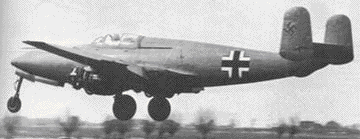The Internet Museum of World War II Aviation | home
Germany | Arado Ar 68 | Arado Ar 234 | Bachem Ba 349 | BV40 | BV 155 | Dornier Do 335 | Fw 187 Falke | Fw 189 Uhu | Fw 190 | Fw Ta 152 | Fw Ta 154 | Heinkel He 51 | Heinkel 100 | Heinkel 112 | Heinkel 113 | Heinkel 162 | Heinkel 219 | Heinkel 280 | Henschel 123 | Junkers Ju88 | Junkers Ju388 | Bf 109 | Bf 110 | Me 210 | Me 410 | Me 163 Komet | Me 262 | Me 263 | Me 328
Heinkel 280
This aircraft is the worlds first turbojet powered fighter, flown for the first time on April 12, 1941. Development of this advanced fighter began in 1939, and a prototype was ready by Sept. 1940. It was first flown as a glider without its turbojets a month before its flight with the power plants installed. It was truely a very advanced aircraft, with tricycle landing gear and a totally new novelty, an ejection seat.
For the first flight of the He 280, the nacelles of the two jets were removed because fuel tended to collect at the bottom of these, posing a serious fire hazard. The fighter climbed, circled, and successfully landed. It was flown again in the next week and this flight was an outstanding success, which was viewed by many important Nazi officials. However, after several flights problems with the turbojets began to reveal themselves. The metals in the engine were not of advanced metallurgy enough to withstand the vigours of jet power, although it was as advanced as possible for that time. There were other problems as well, and over time they were fixed one by one until the jets used were rather reliable.
Also, in early 1942, the aircraft during a flight began to ice up badly, and the pilot ejected safely, although the He 280 was badly damaged. This pilot was unaware that he was the first person in the history of aviation to use an ejection seat in an aircraft! The troublesome HeS turbojets were replaced by the Jumkers Jumo in mid-1942, and also armament was first fitted about this time. In a mock dogfight with the Fw 190, the He 280 showed it was highly superior in speed and maneuverability, but apparently this was not appreciated by the Nazi officials. Thus, the He 280 gradually was phased out, and by 1944, which was the end of the development of the He 280, other more advanced jet fighters had been completed by other companies. There was no longer anything special about the He 280, and the program was cancelled.
Specifications for He 280
Type: Single seat jet interceptor
Engines: two Heinkel Hirth HeS 8A 1,540lb/thrust turbojets
Armament: Three 20-mm MG151 cannon
Performance: Maximum speed 570mph; endurance 46 minutes
